#Temple of Khnum
Explore tagged Tumblr posts
Text
Egypt... the best of the River Nile
Egypt, a land of ancient wonders and modern marvels, beckons travellers with its rich tapestry of history, culture, and natural beauty. #Egypt #RiverNile #Tutankhamun #AncientHistory #History #Luxor #Aswan #RaII #Nile #Cruise #ValleyoftheKings #KingTut
Egypt Egypt, a land of ancient wonders and modern marvels, beckons travellers with its rich tapestry of history, culture, and natural beauty. Among its many jewels, Luxor and Aswan stand out as iconic destinations, offering a glimpse into the grandeur of bygone eras. These cities, situated along the life-giving River Nile, form the heart of many Nile cruises, tracing a route that has been…
#Abu Simbel#adventure#Ancient Egypt#Aswan#blog#complete#Cruise#Edfu#Egypt;#Esna#Karnak#Kom Ombo#Luxor#Luxor Museum#Nile#Nile Cruise#Pharaohs#Ra#RA II#River Cruise#River Nile#Temple#Temple of Karnak#Temple of Khnum#Temple of Queen Hatshepsut#Temple of Sobek#The Ra#travel#travelblog#Tutankhamun
2 notes
·
View notes
Text





Temple of Khnum, Esna
0 notes
Text
Aswan
One of the hottest, driest, and sunniest cities in the world, Aswan with its 350,000 population made a nice change after the 20 million people in Cairo. It is the gateway to the Nile, home to the Aswan and High Dams, which after thousands of years changed the nature of the Nile, for good and bad. One of the most popular sights is the incredible Philae Temple, the last to be built by the ancient…

View On WordPress
#Aga Khan Mausoleum#Aswan#Aswan Bazaar#Aswan Botanical Gardens#Aswan Museum#Coptic Orthodox Cathedral of the Archangel Michael#Egypt#Elephantine Island#Feryal Garden#Nubian Museum#Nubian Village#Philae Island#photography#Temple of Khnum#The Nile#travel
0 notes
Text

the god Khnum accompanied by Heqet, moulds Why in a relief from the birth temple at Dendera Temple Complex.
129 notes
·
View notes
Text


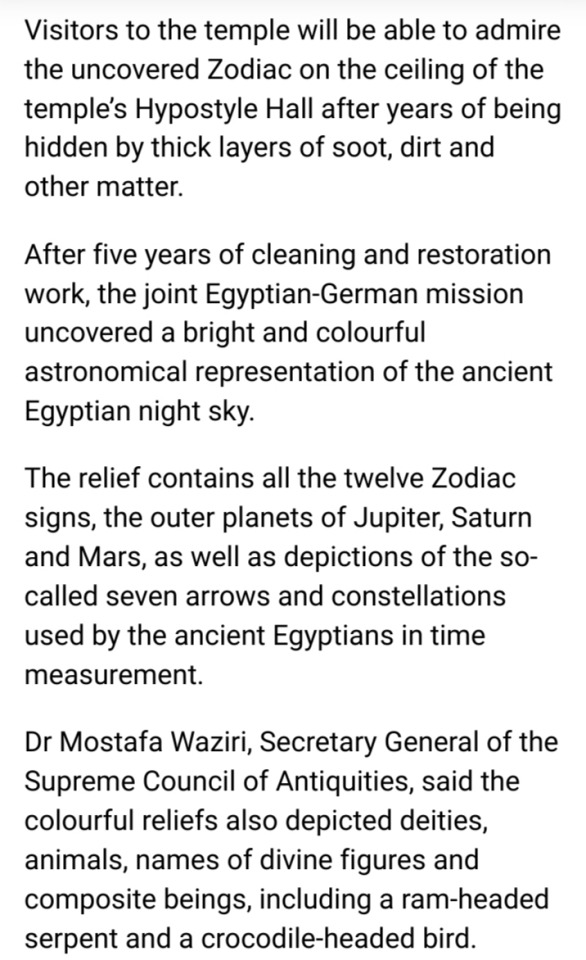

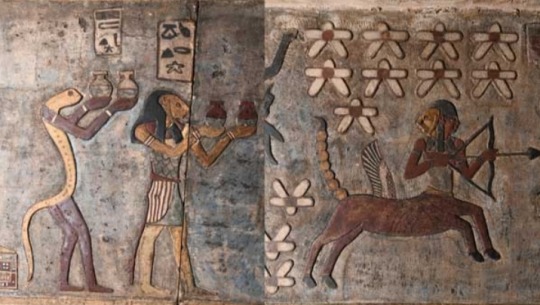

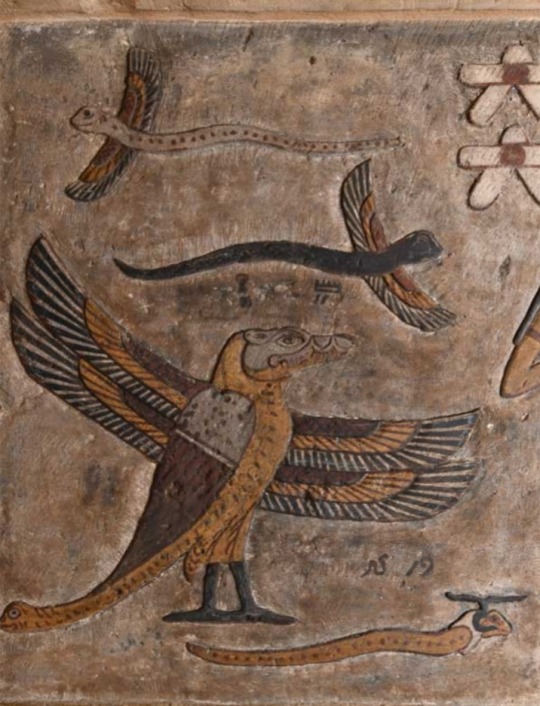
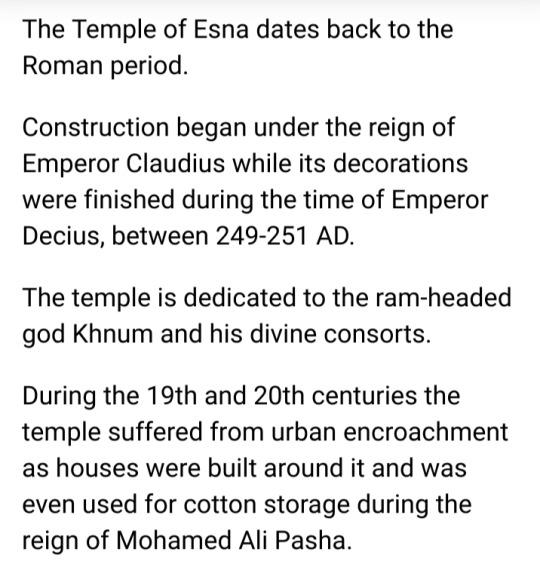

#Temple of Esna#Luxor#Zodiac#Ministry of Tourism and Antiquities#Hypostyle Hall#zodiac signs#Supreme Council of Antiquities#Babylonian astronomy#American Research Centre#Emperor Claudius#Emperor Decius#Khnum#archaeology
132 notes
·
View notes
Text
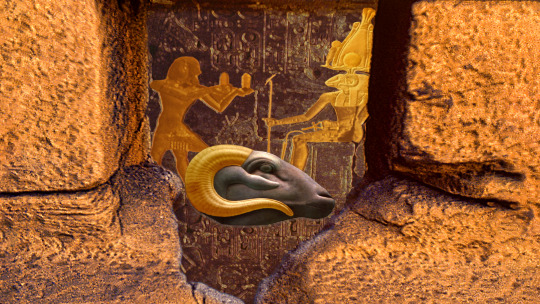
Ram's Horn, the god Khnum at Esna temple
#ancient egypt#archaeology#past future#metaphysical#ram horns#khnum#ancient temple#egyptian gods#hermeticism#egyptian mythology
1 note
·
View note
Text

Relief of Banebdjedet of Mendes in the Temple of Khnum at Esna.
1K notes
·
View notes
Text
Transmasculinity Throughout Time: Hatshepsut
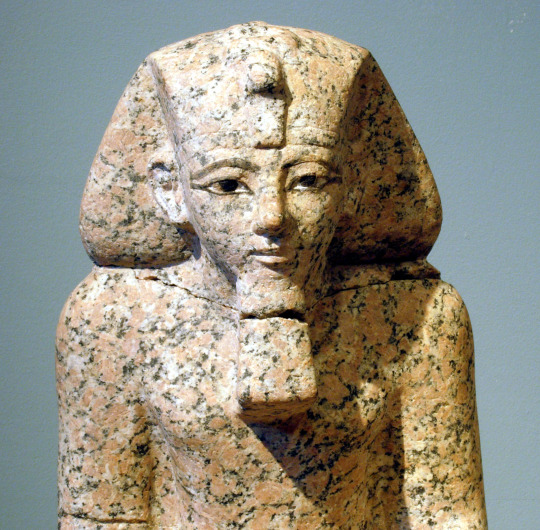
Kicking off this first post in what I hope to be a long series by saying that I am just a guy who likes obsessively researching things and I am absolutely not a historical expert, and in this case, not an Egyptologist. My perspectives and interpretations are my own. You are welcome to have other ones.
Hatshepsut is known as Egypt’s first and only female pharaoh, and is discussed as such throughout almost all material about them. I will be nonetheless using they/them pronouns to refer to them, but during their life they used both masculine and feminine pronouns. The tendency to project modern ideas onto historical figures is common. Especially in the case of people who exhibited signs of transmasculinity, it is common for their entire lives to be reduced to “women who cosplayed as men for power” which is problematic for obvious reasons. Cis men coveting masculinity for the pursuit of power in a patriarchal society is never a reason they are actually women, yet it is okay to do this with historical transmasculine people in the name of feminism? There is a clear double standard. So, I will be using gender neutral pronouns because we can’t really know if Hatshepsut was alive today whether they would identify as a woman, trans man, nonbinary or as none of those identities. I am simply going to be discussing the history and some of my interpretations.
In the context of ancient Egypt, the pharaoh was a living embodiment of the masculine god Horus. Hatshepsut embraced this role after coming to power, ascending from the position of queen regent alongside a child king once their former husband Thutmose II had passed, to “his majesty the king herself.” As their rule progressed, they were depicted as more and more masculine in statues and reliefs, using the same ceremonial fake beard as male pharaohs, muscles, and other masculine signifiers. They didn’t stop wearing makeup and jewelry when presenting as a male king though, which some historians take as evidence to support a female gender identity - it could mean that, but it could also just mean they liked to be fashionable and didn’t subscribe to restrictive gender roles!
Like kings before them, Hatshepsut emphasized their connection to the gods by telling a story to justify their rule. However, the story they told had to be exceptional - and it was. Hatshepsut’s throne name, Maatkare, translated to “truth is the soul of the sun god.” This demonstrated a connection to the sun god, Amun or Ra, and to Maat, the tradition of maintaining harmony in ancient Egypt. The story was that Amun had appeared to their mother who had conceived Hatshepsut for the purpose of being king, commanded by the god of creation Khnum, to “fashion [them] better than all gods” with “the great dignity of a king.” In carvings, Khnum created Hatshepsut as a little boy. This explanation for their lineage is especially interesting because it emphasizes their connection both to their mother’s bloodlines and to being the child of Amun, not ruling as just a queen regent, but as a king.
During their rule of 20 years, Egypt’s trade flourished and there was an immense period of construction during which countless buildings and statues were created, and temples renovated. Unfortunately after their death, extreme measures were taken by Thutmose III to erase all records of Hatshepsut from existence in order to preserve the line of male kings. These efforts were primarily successful, and much of their history has been lost to time. There are many things about Hatshepsut that we will never know.
#transmasculinity throughout time#transandrophobia#transmisandry#antitransmasculinity#transmasculine experiences#trans men#transmasc#hatshepsut#ancient egypt
158 notes
·
View notes
Photo

Ancient Ceiling Reliefs Uncovered in The Egyptian Temple of Esna
The reliefs were buried under millennia of dirt, soot, and bird droppings.
Conservation work on a 2,200-year-old temple in Egypt has uncovered 12 reliefs representing Babylonian zodiac signs, as well as depictions of stars and constellations that the ancients used to measure time.
The images were found carved into the ceiling of the Temple of Esna in Luxor, which was completed around 250 C.E. and dedicated to the Egyptian god of fertility Khnum. They were revealed by a restoration team, made up of archaeologists from the Egyptian Ministry of Tourism and Antiquities and the University of Tübingen in Germany, which cleared away millennia of dirt and bird droppings from the temple’s surfaces to unveil the 12 astrological motifs that are unusual for a site of worship in Egypt.

“Representations of the zodiac are very rare in Egyptian temples,” said Christian Leitz, a professor at the University of Tübingen, who explained that the Babylonian zodiac was probably introduced to Egypt during Ptolemaic rule between 305 and 30 B.C.E.
“The zodiac was used to decorate private tombs and sarcophagi and was of great importance in astrological texts, such as horoscopes found inscribed on pottery sherds,” added Daniel von Recklinghausen, a Tübingen researcher. “However, it is rare in temple decoration. Apart from Esna, there are only two completely preserved versions left, both from Dendera.”


Zodiac signs aside, the restoration effort further unearthed a trove of other reliefs, including illustrations of the planets Jupiter, Saturn, and Mars.
A host of deities and fantastical animals were also found, such as a snake with a ram’s head, a bird with a crocodile’s head, and yet another snake with four wings.

Additionally, researchers discovered some previously unknown inscriptions, which had been covered by soot and inadvertently preserved. Analysis is currently being carried out on these new finds.
Restoration on the Temple of Esna began in 2018, and has involved the cleaning and recoloring of the monument’s surfaces. Along the way, the team has logged finds including a colorful fresco made up of 46 depictions of Egyptian goddesses Nekhbet and Wadjet, as well as painted inscriptions that detail royal titles and caption the constellations carved into the temple’s ceiling.



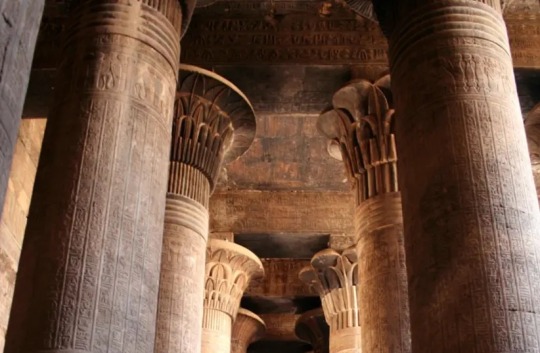
#Ancient Ceiling Reliefs Uncovered in The Egyptian Temple of Esna#Luxor#archeology#archeolgst#ancient artifacts#history#history news#ancient history#ancient culture#ancient civilizations#ancient egypt#egyptian history#egyptian art
692 notes
·
View notes
Text
Neith
𓈖𓏏𓋌𓁐 𓈖𓏏𓋋 𓈖𓏏𓌖 𓋋 𓈖𓏏𓋋𓆎 𓈖𓏏𓋌 𓈖𓏏𓋋𓆗
𓋌 𓈖𓏏𓋋𓁐 𓏏𓏏𓋌
Meaning of her name
Her name possibly means:
"She belonging to Lower Egypt"
"terror", "fear", "terrible one"
Epithets
The father of fathers, mother of mothers
Enduring of love
The divine mother who protects Horus
Lady of the West
Neith who shines from the Akhet
Chief of the Nine Bows
Mighty of rage
Foremost of Per-netjer
Areas of worship
Esna. Ḥwt-Nt, or known as the Temple of Neith. Her and Khnum's temples were called Ḥwt-B3w , or the Temple of the Souls.
Temple of Neith at Satis
Offerings
Bow and arrows
Lapis lazuli
Turquoise
Jasper
Meat
Bread
Beer
Honey
Wine
Water
Spider web iconography
Knitting tools, yarn, fabrics
A loom
Information
Neith had emerged from the primordial waters, turning into a cow and then a *lates* fish. From there she brought thirty gods out of the primordial waters and raised the “High Mound” for her and her children. She possesses the power to control everything within the cosmos through thought, speech and names. She’s associated with weaving, with weaving being a symbol of the cosmic order and her divine wisdom. Her association with weaving, led her to being associated with making the bandages for the dead, but she herself had created the Duat for the deceased to pass through. She would enliven the dead and protect them during the passage through the underworld with her bow and arrows, which was a trademark symbol for the Great Goddess. Her symbol of the bow and arrows made her a goddess of hunting, later becoming war, and protector of her son, Re. She is the patroness of victorious weapons and would protect both the dead and alive from enemies or those who sought to harm the King and his heirs. Even when those she protected were harmed, you could seek her for her ability to heal.

Bibliography and more notes posted here
Image from:
#neith#kemetic#information on egyptian gods#kemetic paganism#kemetism#ancient egypt#ancient kemet#egyptian mythology#pagan#paganism#deity work#deity worship#goddess neith#egyptian gods#egyptian goddess#deities#ancient religion#netjeru#netjer#kemetic pagan#kemetic gods#pagan gods#pagan goddesses#mother goddess#protection goddess#war goddess#creation goddess#creation myth#fertility goddess#death goddess
15 notes
·
View notes
Text

Re ∆.∆∆ Also known as: Atum-Re, Chnum-Re, Pra, Ra, Re-Atum Talon Abraxas
Re, in ancient Egyptian religion, god of the sun and creator god. He was believed to travel across the sky in his solar bark and, during the night, to make his passage in another bark through the underworld, where, in order to be born again for the new day, he had to vanquish the evil serpent Apopis (Apepi). As one of the creator gods, he rose from the ocean of chaos on the primeval hill, creating himself and then in turn engendering eight other gods.
Karnak: avenue of sphinxes
Avenue of sphinxes leading to the main temple precinct at the ruins of the Great Temple of Amon at Karnak, Egypt.
Originally most solar gods had falcon form and were assimilated to Horus. By the 4th dynasty (c. 2575–c. 2465 bce), however, Re had risen to his leading position. Many syncretisms were formed between Re and other gods, producing such names as Re-Harakhty, Amon-Re, Sebek-Re, and Khnum-Re. Aspects of other gods influenced Re himself; his falcon-headed appearance as Re-Harakhty originated through association with Horus. The influence of Re was spread from On (Heliopolis), which was the centre of his worship. From the 4th dynasty, kings held the title “Son of Re,” and “Re” later became part of the throne name they adopted at accession. As the father of Maat, Re was the ultimate source of right and justice in the cosmos.
23 notes
·
View notes
Text





Elephantine Island (2) (3) (4) (5) by Panegyrics of Granovetter
Via Flickr:
(1) Vulture of Aswan. (2) (3) (4) Temple of Khnum - dedicatory inscriptions, architectural fragment. (5) A gentle donkey near the shores of the Nile.
#relief sculpture#stone carving#temple#ruins#rivers#columns#donkeys#egypt#upper egypt#southern egypt#aswan governate
16 notes
·
View notes
Text
Quick question
Is it Temple of Khnum Esna? Or Temple of Hathor Dendara?
6 notes
·
View notes
Text
Egyptian gods: Hapi
The Nile wasn’t just the only river of Egypt and its main body of water: the Nile was the water around which Egypt built itself and without which Egyptians couldn’t survive. Their religion, society and calendar all shaped themselves based on the Nile, because it was a crucial element in the life of any Ancient Egyptian. The three seasons of the Egyptian calendars were “shemu”, “the sowing”, “peret”, “the harvest” and “akhet”, “the flooding”. You see, the Nile had a yearly flooding, and this even was so important that it became the focus of an entire Egyptian season. The flooding actually poured water over the fields and crops surrounding the Nile, helping the plants grow for the future harvest, and it also left on the shores a lot of silt, which fertilized the earth. Without the yearly flood of the Nile, the lands near it would end up as dry and arid as other parts of Egypt, and the crops would fail, meaning an ensured famine. But on the flipside, the Nile’s flooding could become very dangerous, because if it was too big, too brutal, too violent, it could drown fields and destroy crops instead of helping them grow… As a result, Egyptians made sure they used all the religious and magical methods they could to be certain of having a “good flood” each year. And one of those means was by personifying and embodying the measured and fertilizing flood in the shape of a god: the very-well named Hapi.
Hapi was the spirit of the Nile and the divinization of the Nile’s flood. He was the being that gave the waters of the Nile their movement, vitality and fertility – he was the one who made sure the good black silt ended up on the shores, and that Egypt became a land of prosperity. Pharaohs whose rule led to a time of abundance for Egypt were often depicted as Hapi on paintings. Among the god’s titles you could find “Lord of the River Bringing Vegetation”, or “Lord of the Fish and the Birds of the Marshes”. Hapi was believed to live in an underground cavern, under the first cataract of the Nile, near Aswan, under the island of Elephantine. There, each year the god started the yearly flood by pouring two enormous jars of water into the river. Once this was done, Hapi left this first lair of his to move to the other part of Egypt, the Lower-Egypt, where he settled in a grotto located this time near Memphis, and there he also poured two jugs of water, to make sure the flood happened in both parts of the country. These two areas were also the places where his cult took place, and where people threw in the water food, sacrificed animals or magical amulets to make sure Hapi would be kind to them – a lot of food was also thrown into the Nile during Hapi’s feast day, the feast of Ope, which celebrated the arrival of the flood (the flood itself being called “the arrival of Hapi”). In Upper-Egypt, Hapi was notably said to work with the god ruling over his living region, Khnum, and with two local Nile-guardian deities, Anukis and Satis: it was said they formed the stocks of silt that later Hapi delivered on the shores of the Nile.
Hapi is very noticeable due to his unique androgynous appearance. Hapi was a man, and paintings clarified that by having him wear the “fake-beard” typical of pharaohs (again, the pharaoh was identified with Hapi because he was supposedly in charge of maintaining the prosperity and abundance of Egypt). However, Hapi also sports long and fleshy female breasts, which are a physical manifestation of him being a spirit of fecundity and fertility. To that is added a rotund and plump belly, which was a visual manifestation of wealth. Sometimes Hapi was depicted with a bluish-green skin, supposed to be the same color as the waters of the Nile. More interestingly, Hapi was often “multiplied”. For example, many paintings depict a full line of Hapis coming towards the master of a temple – these multiple Hapis, called “the Niles”, were supposed to depict the many subdivisions of the river. Each one holds a different item in his hands: flowers, fruits, fishes… They are the various offerings born out/produced from each of the regions of Egypt, and if the Niles bring them to the master of a temple, it is because Hapi offers what he produces to the gods. Indeed, despite his very important role in the Egyptian life, Hapi wasn’t considered a superior or major god – no, he was rather a minor and secondary deity, who must often acted as the servant of more powerful gods and goddesses, and who fed them with the products of his own fertility. A much more common depiction of Hapi was the “Hapi twins” – painting Hapi not as one, but as two identically-looking deities, which intertwined plants together. This dual representation was meant to represent the Nile portion of Upper Egypt and the Nile portion of Lower Egypt, which united their forces and worked together to make Egypt one great and rich nation: one Hapi was crowned with and holding in his hand papyrus leaves, symbolizing Upper-Egypt, while the other was crowned with and holding in his hand lotus flowers, the flower of Lower Egypt. Their alliance was symbolized by how they intertwined these two regional plants together – it was called the “sema-taouy”, the symbolical union of Upper and Lower Egypt. [In terms of animal-companions, the Upper Egypt Hapi was usually surrounded by crocodiles, whereas the Lower Egypt one was followed by frogs]
Beyond his role as the spirit of the Nile, Hapi also had another function as a funeral god! Indeed, in the process of mummification, the Egyptians removed from their dead four organs deemed to be sacred and essential to the survival of the deceased in the afterlife – these organs were to be kept in special urns called the “canopy vases”. To make sure these precious elements were not destroyed, each canopy vase was shaped in the image of a minor god, who together were supposed to guard the organs. Hapi was one of those four gods – in charge of keeping the lungs of the dead. The other three gods were Imsety (a human-looking god) watching over the liver, Qebehsenuef (falcon-god) watching over the intestines, and Duamutef (jackal-god) guarding the stomach. Together, these four guarding deities were collectively known as “The Four Sons of Horus”.
EDIT: I checked and discovered that, quite fascinatingly, while sometimes in Egyptian mythology Hapi was seen as a minor figure, a secondary spirit that mostly acted as a servant and “feeder” of the gods (as I described above), other times he was described in the very opposite way. Due to all of the fertility of Egypt relying on him, he was sometimes called the “father of the gods”, and seen as the source of every life, as well as the one maintaining the balance and order of the cosmos through a measured annual flooding. After all, the river Nile (and thus Hapi himself) were thought to come from/be formed out of the Nun, the primordial water and primitive ocean before the world was created and from which the first gods and the sun itself were born.
19 notes
·
View notes
Text






Anuket
Other names:Anaka, Anqet, Anoukis, Ανουκις
Major cult center:Elephantine, Seheil
Symbols:Bow, arrows, gazelle, ostrich feather
Domain: The Nile
Parents:Khnum and Satet
Siblings:Sometimes Satis
Greek equivalent:Hestia
Roman equivalent:Vesta
In ancient Egypt, she was known as Anuket, Anaka,or Anqet. Her name meant the "Clasper" or "Embracer".In Greek, this became Anoukis (Ανουκις),sometimes also spelled Anukis. In the interpretatio graeca, she was considered equivalent to Hestia or Vesta
Anuket was usually depicted as a woman with a headdress of either reed or ostrich feathers. She was usually depicted as holding a sceptre topped with an ankh, and her sacred animal was the gazelle. She was also shown suckling the pharaoh through the New Kingdom and became a goddess of lust in later years. In later periods, she was associated with the cowry, especially the shell, which resembled the vagina.
History and Role
She was originally the daughter of Ra, but was always related to Satet in some way. For example, both goddesses were called the "Eye of Ra", along with Bastet, Hathor, and Sekhmet. Also, they were both related in some way to the Uraeus.
Worship
Anuket was part of a triad with the god Khnum, and the goddess Satis. She may have been the sister of the goddess Satis or she may have been a junior consort to Khnum instead.
A temple dedicated to Anuket was erected on the Island of Seheil. Inscriptions show that a shrine or altar was dedicated to her at this site by the 13th Dynasty pharaoh Sobekhotep III. Much later, during the 18th Dynasty, Amenhotep II dedicated a chapel to the goddess.
During the New Kingdom, Anuket's cult at Elephantine included a river procession of the goddess during the first month of Shemu. Inscriptions mention the processional festival of Khnum and Anuket during this period.
──────⊰In Workings⊱──────
Ideas for honoring and working with/worshiping Anuket
*Please know basic protections and energy work before attempting any deity work.*
*It is important to note that everyone's experiences are different and will work with spirits for different reasons. Some people may like a spirit while others will not and that's okay. Ask these spirits what they will work with you on as well as ask them if they can help you with whatever it is you need.*
Anuket the goddess of the Nile and later lust. She represents the water that flows.
Altar
Create an altar/sacred space for your rituals and giving offerings for Anuket. Items may include
⬩An altar cloth
⬩Cup or chalice
⬩Incense and an incense burner
⬩Offering bowl
⬩Statue of Anuket
For more information on basic altar setups and deity work check out the deity work post.
Offering items:Blue lotus, Bread, Frankincense, Papyrus, Myrrh, Vegetable, Water
Rituals
⬩Honoring the water of the Earth
⬩Fertility rites and rituals
⬩Lust rituals
⬩You can ask her what she will help you with
𓈖𓈖𓈖𓈖𓈖𓈖𓈖𓈖𓈖𓈖𓈖𓈖𓈖𓈖𓈖𓈖𓈖

For more content relating to other practices/religions or pantheons follow my main blog for updates.
If you have any more questions or wish to join a community feel free to join my 18+ discord server
Ask me anything on my blog
#occult#spirituality#spirit#spirits#paganblr#occultblr#kemetic#kemet#kemetism#witchcraft#deity#witchblr#Anuket#Goddess Anuket#kemeticism#neter#neteru#kemetblr#paganism#pagan#pagan witch#witch#beginner kemet#neterism#baby witch#baby pagan
9 notes
·
View notes
